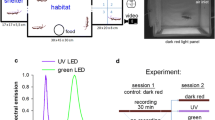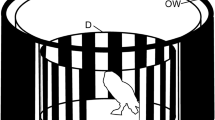Summary
-
1.
The dorsal ocelli of the locust Locusta migratoria and the cricket Gryllus bimaculatus control through photoinhibition the relative strength of the phototactic turning tendency of one type of phototropotaxis, the inversely proportional prophototaxis.
-
2.
In grasshoppers and crickets (Saltatoptera) the afferences from the dorsal ocelli and the complex eyes are combined in the positive and negative phototaxis according to the “principle of phototactic push-pull coupling”: under weak illumination the dorsal ocelli control the phototaxis as synergists and under stronger illumination as antagonists of the complex eyes.
-
3.
In the ocellar system of the cricket Gryllus bimaculatus the lateral ocelli, analogous to the complex eyes, perceive the predominant light direction according to the principle of the phototropotaxis and command corresponding turning movements. The level of illumination of the median ocellus determines wether the tropotactic commands of the lateral ocelli and the complex eyes join synergistically or antagonistically.
-
4.
The principle of the phototactic push-pull coupling stabilizes the prophototaxis against disturbances due to light intensity fluctuations.
Zusammenfassung
-
1.
Bei einem Typ der Phototropotaxis, der umgekehrt proportionalen Prophototaxis (Jander, 1963), kontrollieren die Stirnocellen von Locusta migratoria und Gryllus bimaculatus photoinhibitorisch die Stärke der phototaktischen Dreherregung.
-
2.
Die Afferenzen der Stirnocellen und der Komplexaugen von Springheuschrecken (Saltatoptera) sind bei der positiven und negativen Phototropotaxis nach dem Prinzip der phototaktischen Gegenkopplung miteinander verknüpft: Bei schwacher Beleuchtung greifen die Stirnocellen als Synergisten der Komplexaugen und bei starker als Antagonisten der Komplexaugen in den Regelkreis der Tropotaxis ein.
-
3.
Die Grille Gryllus bimaculatus percipiert mit ihren beiden lateralen Stirnocellen ähnlich wie mit den beiden Komplexaugen nach dem Prinzip der Tropotaxis die vorherrschende Lichtrichtung. Diese tropotaktischen Richtungsmeldungen der Lateralocellen und der Komplexaugen werden bei Verdunkeln des Medianocellus synergistisch und bei seiner Belichtung antagonistisch zusammengeschaltet.
-
4.
Durch das Prinzip der phototaktischen Gegenkopplung wird die Phototropotaxis gegenüber Störungen durch Helligkeitsschwankungen stabilisiert.
Similar content being viewed by others
Literatur
Autrum, H. J., u. N. Metschl: Beziehungen zwischen Lichtreiz und Erregung im Ocellarnerven von Calliphora erythrocephala. Z. Naturforsch. 16b, 384–388 (1961).
—: Die Arbeitsweise der Ocellen der Insekten. Z. vergl. Physiol. 47, 256–273 (1963).
Bayramoglu-Ergene, S.: Die Funktion der Ocellen bei Anacridium aegypticum. Z. vergl. Physiol. 49, 465–474 (1965).
Bozler, E.: Experimentelle Untersuchungen über die Funktion der Stirnaugen der Insekten. Z. vergl. Physiol. 3, 145–182 (1926).
Bullock, Th. H., and G. A. Horridge: Structure and function in the nervous systems of invertebrates. II. San Francisco 1965.
Burtt, E. T., and W. T. Catton: Electrical responses to visual stimulation in the optic lobes of the locust and certain other insects. J. Physiol. (Lond.) 133, 68–88 (1956).
Cassier, P.: Role des ocelles frontaux chez Locusta migratoria migratorioides. Insectes sociaux 9, 213–230 (1962).
—: Contribution a l'étude du comportement phototropique du criquet migrateur (Locusta migratoria migratorioides R. et F.). Ann. Sci. natur. Zool. Sér XII, 7, 213–358 (1965).
—: Contribution à l'étude des réactions photo-ménotactique du criquet migrateur: Locusta migratorioides (R. et F.). Leur déterminisme sensoriel. Insectes sociaux 12, 365–381 (1965).
Chen, S. H., and B. Young: Vision and flight: an experimental studie on the cicada Cryptotympana pustulata. Sinensia 14, 55–60 (1943).
Cornwell, P. B.: The function of the ocelli of Calliphora (Diptera) and Locusta (Othoptera). J. exp. Biol. 32, 217–237 (1955).
Demoll, R., u. L. Scheuring: Die Bedeutung der Ocellen der Insekten. Zool. Jb., Abt. allg. Zool. u. Physiol. 31, 519–628 (1912).
Ducke, H.: Biologische Notizen über einige südamerikanische Hymenopteren. 1. Über die Bedeutung der Ocelli bei den Hymenopteren. Allg. Z. Entomol. 8, 308–269 (1903).
Dufay, C.: Contribution à l'étude du phototropisme des Lépidoptères Noctuides. Ann. Sci. natur. Zool. Sér. XII, 6, 281–406 (1964).
Götze, G.: Untersuchungen an Hymenopteren über das Vorkommen und die Bedeutung der Stirnaugen. Zool. Jb., Abt. allg. Zool. u. Physiol. 44, 211–268 (1928).
Goodman, L. J.: The role of certain optomotor reactions in regulating stability in the rolling plane during flight in the desert locust Schistocerca gregaria. J. exp. Biol. 42, 385–407 (1965).
Goustard, M.: Le complexe oculo-ocellaire et le comportement spaciocinétique chez Blatella germanica. C. R. Acad. Sci. (Paris) 242, 1517–1518 (1956).
- Réactions phototropique et régulation du comportement chez l'imago mâle du Blatella germanica. Bull. biol. France et Belg., Suppl. 45 (Thèse) (1958).
Homann, H.: Zum Problem der Ocellenfunktion der Insekten. Z. vergl. Physiol. 1, 541–578 (1924).
Hoyle, G.: Functioning of the insect ocellar nerve. J. exp. Biol. 32, 379–407 (1955).
Jander, R.: Die optische Richtungsorientierung der Roten Waldameise (Formicarufa L.). Z. vergl. Physiol. 40, 162–238 (1957).
—: Grundleistungen der Licht- und der Schwereorientierung von Insekten. Z. vergl. Physiol. 47, 381–430 (1963).
- Die Phylogenie von Orientierungsmechanismen der Arthropoden. Verh. Dtsch. Zool. Ges. Jena 1965, S. 266–306.
Kerfoot, W. B.: Correlation between ocellar size and the foraging activities of bees (Hymenoptera; Apoidea). Amer. Naturalist 101, 65–70 (1967).
Lienert, G. A.: Verteilungsfreie Methoden in der Biostatistik. Meisenheim 1962.
Lindauer, M., u. B. Schricker: Über die Funktion der Ocellen bei den Dämmerungsflügen der Honigbiene. Biol. Zbl. 82, 721–725 (1963).
Link, E.: Über die Stirnaugen der Orthopteren. Verh. Dtsch. Zool. Ges. Leipzig 1908, S. 161–167.
—: Über die Stirnaugen der hemimetabolen Insekten. Zool. Jb., Abt. Anat. u. Ontog. 27, 281–376 (1909).
Marlier, S. R.: Recherches sur les organes photorécepteurs des insectes aptilotes. Ann. Soc. zool. Belg. 72, 204–236 (1941).
Médioni, J.: Mise en évidence et évaluation d'un effect de stimulation dû aux ocelles frontaux dans le phototropisme de Drosophila melanogaster Meign. C. R. Soc. Biol. (Paris) 153, 1587–1590 (1959).
- Contribution à l'étude psychophysiologique et génétique du phototropisme d'un insecte: Drosophila melanogaster. Thèse Fac. Sci. Strasbourg 1961, No 203.
Metschl, N.: Elektrophysiologische Untersuchungen an den Ocellen von Calliphora. Z. vergl. Physiol. 47, 230–255 (1963).
Mittelstaedt, H.: Physiologie des Gleichgewichtssinnes bei fliegenden Libellen. Z. vergl. Physiol. 32, 422–463 (1950).
Müller, E.: Experimentelle Untersuchungen an Bienen und Ameisen über die Funktionsweise der Stirnocellen. Z. vergl. Physiol. 14, 348–384 (1931).
Münchberg, P.: Zum morphologischen Bau und zur funktionellen Bedeutung der Ocellen der Libellen. Beitr. Entomol. 16, 221–249 (1966).
Ruck, Ph.: The electrical responses of dorsal ocelli in cockroaches and grasshoppers. J. Insect Physiol. 1, 109–123 (1957).
—: A comparison of the electrical responses of compound eyes and dorsal ocelli in four insect species. J. Insect Physiol. 2, 261–274 (1958).
—: Electrophysiology of the insect ocellus. II. Mechanism of generation and inhibition of impulses in the ocellar nerve of dragon-flies. J. gen. Physiol. 44, 629–639 (1961).
Schremmer, F.: Bemerkungen zur Ocellenfunktion bei Hummeln. Öst. zool. Z. 2, 242–274 (1950).
Schricker, B.: Die Orientierung der Honigbiene in der Dämmerung. Zugleich ein Beitrag zur Frage der Ocellenfunktion bei Bienen. Z. vergl. Physiol. 49, 420–458 (1965).
Wellington, W. G.: Motor responses evoked by the dorsal ocelli of Sarcophaga aldrichi Parker and the orientation of the fly to plane polarized light. Nature (Lond.) 172, 1177–1179 (1953).
Author information
Authors and Affiliations
Additional information
Mit Unterstützung der Deutschen Forschungsgemeinschaft.
Rights and permissions
About this article
Cite this article
Jander, R., Barry, C.K. Die phototaktische Gegenkopplung von Stirnocellen und Facettenaugen in der Phototropotaxis der Heuschrecken und Grillen (Saltatoptera: Locusta migratoria und Gryllus bimaculatus). Z. Vergl. Physiol. 57, 432–458 (1968). https://doi.org/10.1007/BF00303067
Received:
Issue Date:
DOI: https://doi.org/10.1007/BF00303067




